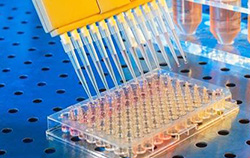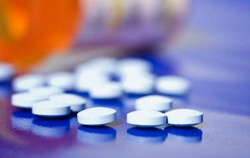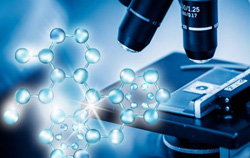








Enzyme-linked Immunosorbent Assay (ELISA) is a widely used technique to measure antibodies, antigens, glycoproteins in various samples. The assay relies on antigen-antibody interactions that allows the identification of a target component qualitatively and quantitatively. Formats of direct ELISA, indirect ELSIA, Sandwich ELISA and competitive ELSIA have been developed. No matter which ELISA format is adopted, the key to a successful method is to choose proper immobilized antigen and capture-detection antibody pairs to ensure method specificity and sensitivity.

Flow cytometry (FCM) is the measurement of cells with fluorescence labeled antibodies (and antibody combinations) using a flow cytometer, which delivers the cells singly past a point of light measurement. The scattered light and fluorescence of different wavelengths are then recorded and plotted on a cytogram. The advantage of FCM is to measure a large number of single cells within a short period of time (tens of seconds to minutes). The heterogeneity of cell populations can be revealed and different subsets of cells can be identified, quantified, and physically sorted for further study. FCM is increasingly used in research fields of cell cycle, cell physiology, immunophenotyping etc.

Cell isolation is to separate particular subsets of living cells from blood or tissues using magnetic particles coupled with high-specific antibodies to cell surface antigen. Targeted cells are isolated when they are in a magnetic field via the magnetically selection and antibody-antigen interaction. Cell isolation is widely used to isolate Pan T cells, CD4+ T cells, CD8+ T cells, Monocyte cells, B cells, Stem cells, NK cells, Dendritic Cells, Endothelial cells, Tumor cells, Leucocytes, Granulocytes from human and animal tissues or blood samples. Isolated living cells with minimal damage can be released from the beads and used for downstream applications such as cell culture, flow cytometry and cell-based assays.

Cell culture is to manipulate cell differentiation and metabolic function under controlled conditions within the laboratory. Primary cells are isolated from human or animal donor tissues. The cells are usually highly differentiated and resemble the parental primary tissues but typically nonproliferative. Cell lines derived from tumors or tissues, on the other hand, are highly proliferative and culturable, although not accurately replicate the primary source.
Some cell derived from primary tissues, such as embryonic (hESCs) and mesenchymal stem cells, fibroblasts, or hepatocytes requires adherent growth on surface of flasks or multi-well plates, or roller bottles. Cell proliferation by adherent culture is limited by available surface area. Other cells or engineered cells are adapted to grow in suspension in shake flask or bioreactor for large-scale manufacturing of biological drug products.





New drug development process includes four steps: discovery and development, preclinical research, clinical research, and regulatory filing for market authorization. Drug metabolism research plays a guiding role in the first two steps, especially in the early stage of drug screening and evaluation.
With an aid of various in vitro metabolic strategies, metabolic characteristics of candidate compounds can be explicated via testing of metabolic stability, metabolite production, metabolic phenotype, enzyme inhibition IC50, etc. Candidates with undesired properties such as fast-metabolizing rate can be improved with better understanding of elucidated metabolic pathway and identified metabolites. New candidate compounds can also be obtained by synthesizing active metabolites or simulating the structure of active metabolites.
Results obtained from early-stage in vitro metabolism study can be used to predict in vivo pharmacokinetic (PK) behavior of candidate compounds. A comprehensive PK analysis will substantially increase the success rates of new drug development through suitable study design guided by PK parameters for PD study, safety evaluation, and even clinical trials in human.

Usually, to fully elucidate the genotoxic potential of test substances and underlying mechanisms, a battery of genotoxicity studies will be conducted using different end-points or the same end-points in various biological systems. In vitro genotoxicity assays represent simple, robust and time- and cost-effective testing and in vivo studies give a better selection of appropriate cells or identified target organs.
Various genotoxicity test methods, including bacterial reverse mutation test (Ames test), in vitro chromosome aberration test, in vitro micronucleus test, in vitro TK gene mutation test of mouse lymphoma L5178Y cells, HGPRT gene mutation test, comet assay, etc., are developed for endpoints of gene mutation, chromosome aberration and DNA damage,
iPhase has developed series of commercialized kits accordingly, including Ames kit, chromosome aberration kit, micronucleus test kit, TK/HGPRT gene mutation kit, comet test kit, etc., aiming to improve efficiency of testing with quality assured performance.

Matrix effect is inevitable in mass spectrometry detection. Blank matrix is essential for evaluation the matrix effects of bioanalytical method establishment and validation. For xenobiotic substances such as drugs and pollutants, biological samples collected from healthy human people or animals (plasma, plasma, urine, bile, etc.) are commonly used as blank matrix. For endogenous substances that are inherent in human or animals, such as cortisol, bilirubin, vitamins, etc., biological samples are not appropriate matrix to be adopted. Under such case, artificial matrix with defined components can be used alternatively to simulate the internal environment of human body or animal without interference of endogenous origin.
IPHASE has developed various blank biological matrix products and artificial matrix products. Biological samples including serum, plasma, urine, bile, feces, and tissues are collected from animal species and human of traceable and reliable sources. Artificial matrix inducing artificial plasma, artificial urine, artificial gastric juice, and artificial small intestinal juice, are prepared following standard operational procedures. These matrix products provide fundamental support for bioanalysis of macromolecules and small molecules during drug development, PK, and TK studies.

Inter-laboratory quality assessment, also known as proficiency testing (PT) is one important component of quality management system in clinical laboratories and medical institutions. It can be used as an objective scale to determine the proficiency of a laboratory in its measurements and methods.
IPHASE has a comprehensive testing platform and more than ten years of analytical experiences in the field. We offer high-quality reference materials and quality control materials, to support PT programs national wise.








400-108-5856


support@iphasebio.com























